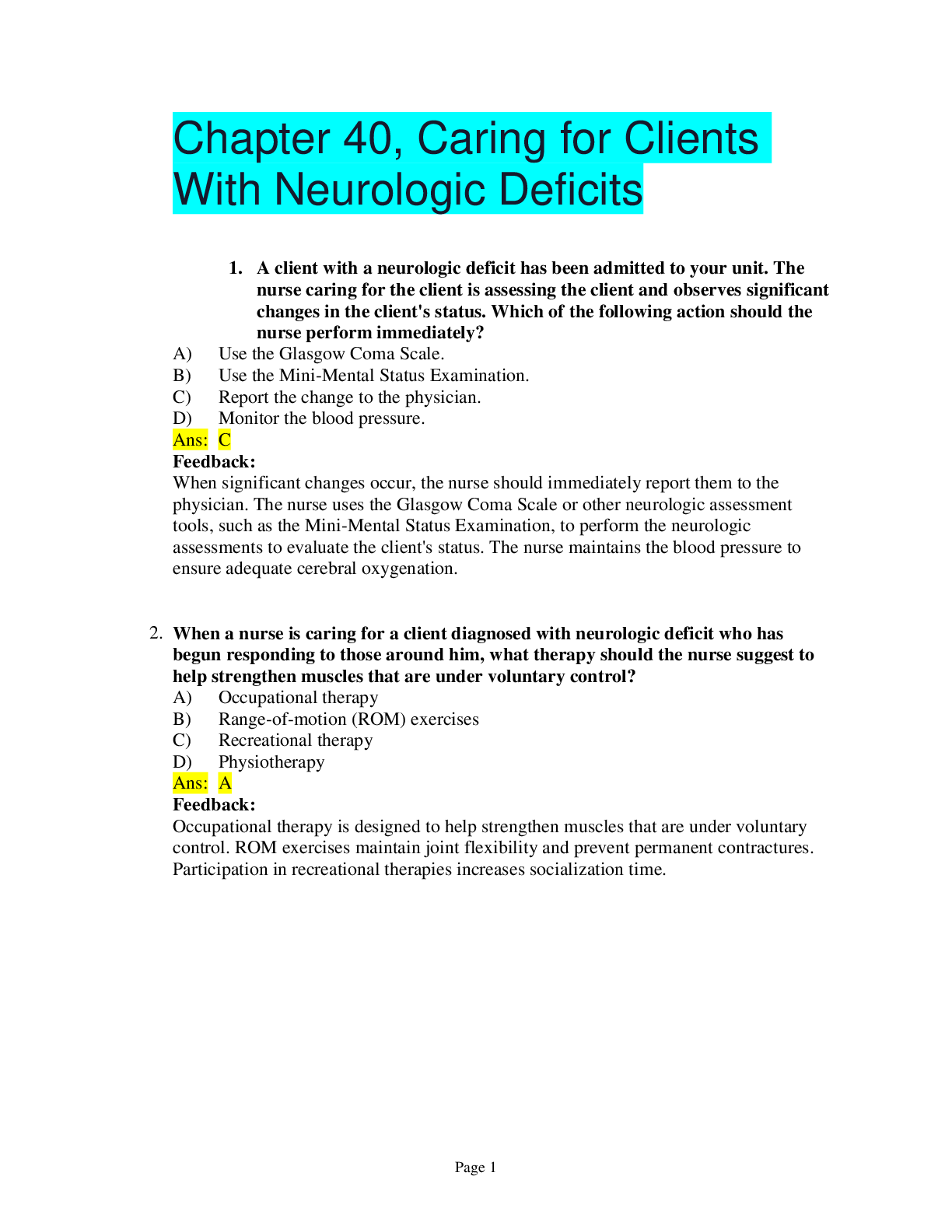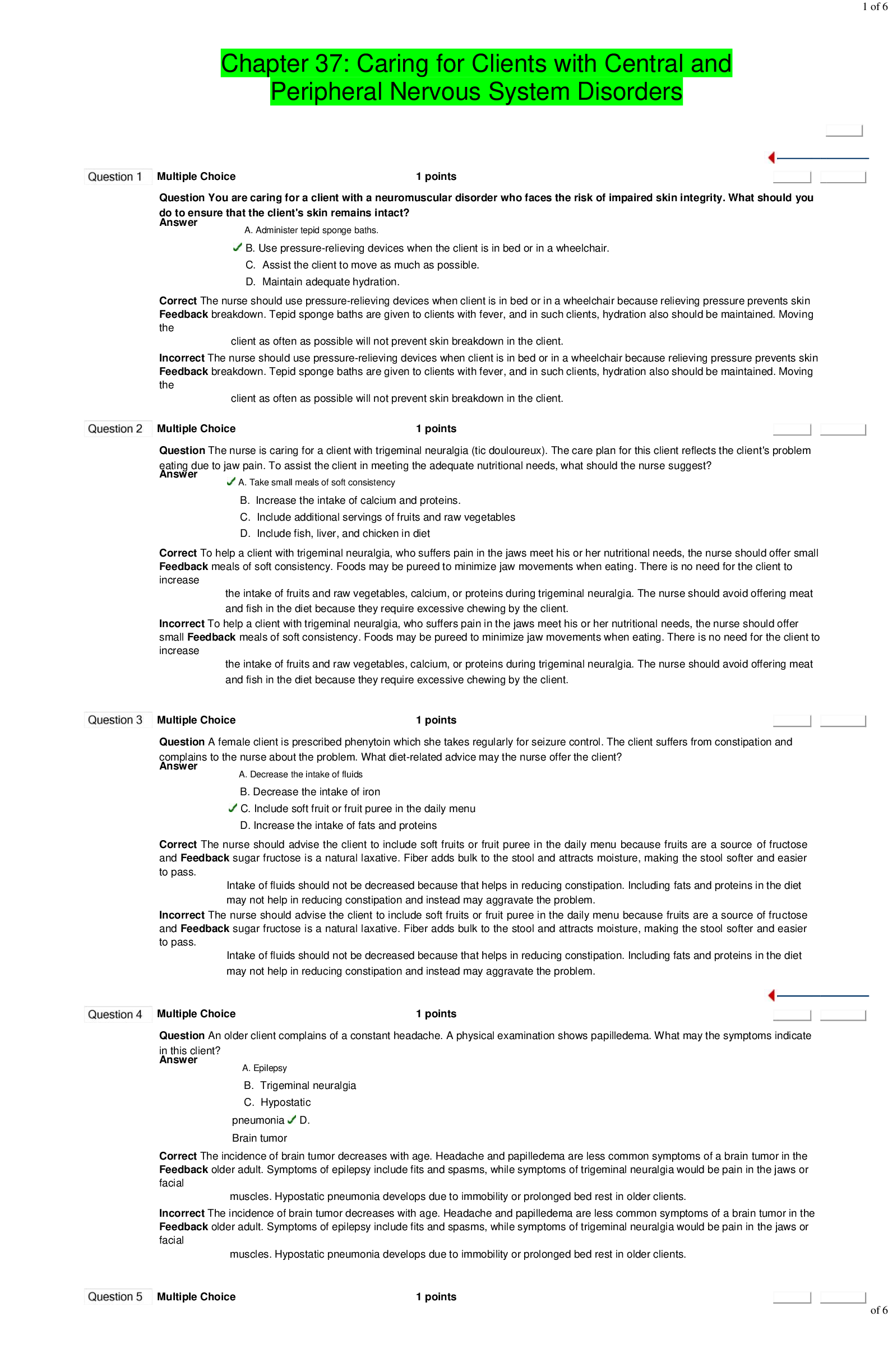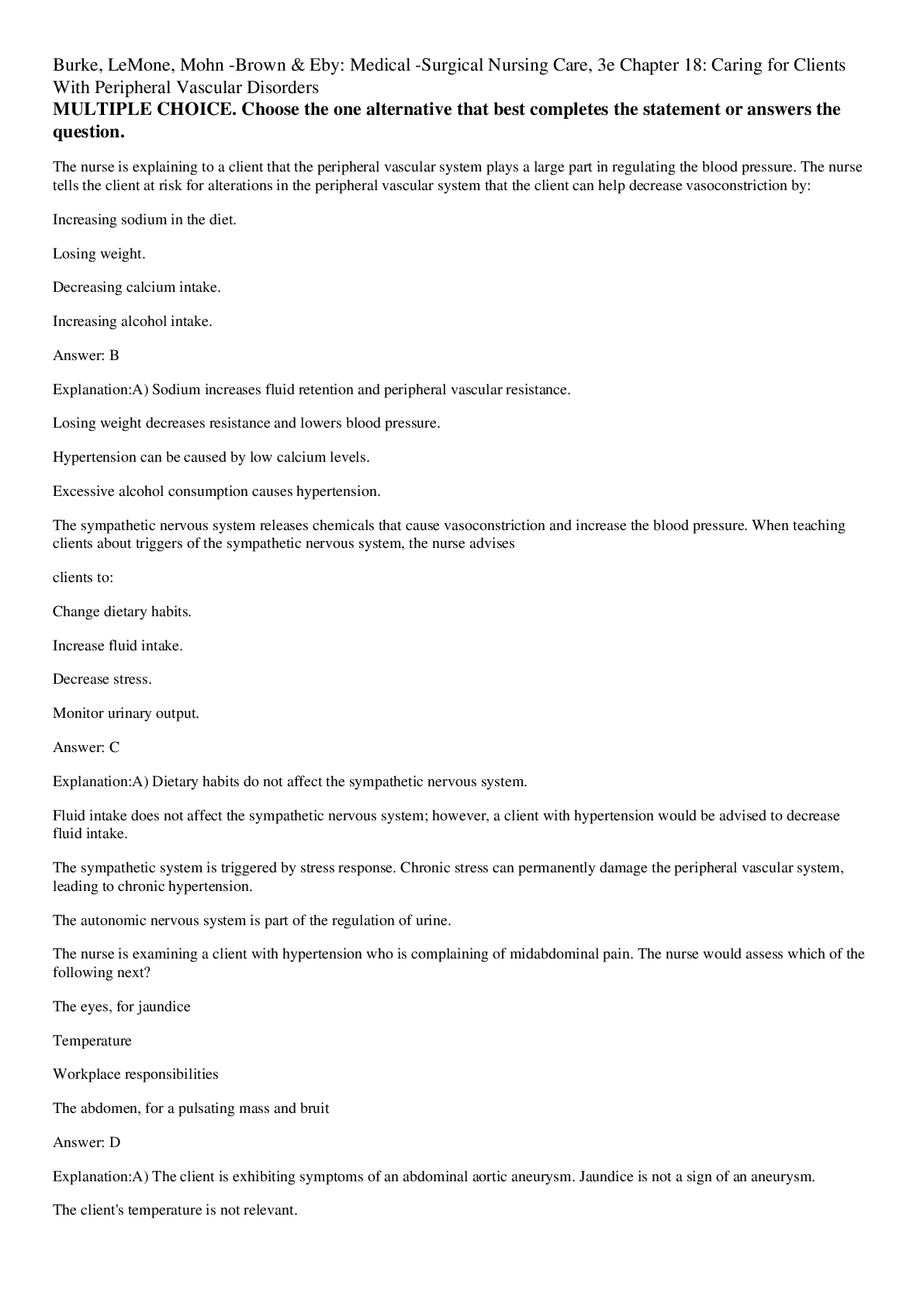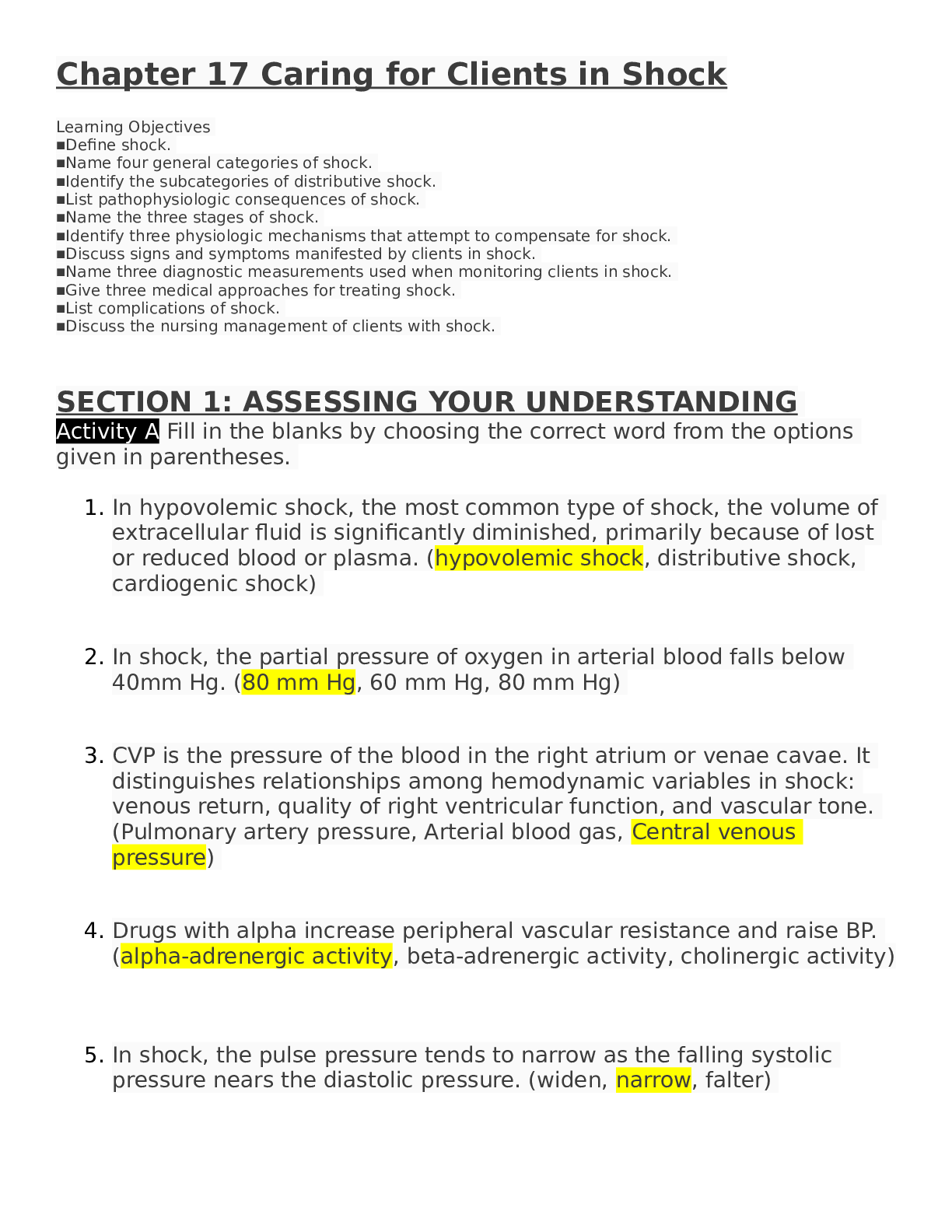*NURSING > QUESTIONS & ANSWERS > Chapter 40, Caring for Clients With Neurologic Deficits (GRADED A) (All)
Chapter 40, Caring for Clients With Neurologic Deficits (GRADED A)
Document Content and Description Below
Chapter 40, Caring for Clients With Neurologic Deficits 1. A client with a neurologic deficit has been admitted to your unit. The nurse caring for the client is assessing the client and observes ... significant changes in the client's status. Which of the following action should the nurse perform immediately? A) Use the Glasgow Coma Scale. B) Use the Mini-Mental Status Examination. C) Report the change to the physician. D) Monitor the blood pressure. 2. When a nurse is caring for a client diagnosed with neurologic deficit who has begun responding to those around him, what therapy should the nurse suggest to help strengthen muscles that are under voluntary control? A) Occupational therapy B) Range-of-motion (ROM) exercises C) Recreational therapy D) Physiotherapy 3. A nursing instructor is teaching the senior nursing class about clients with neurologic disorder. The instructor tells the students that these clients are at risk of disuse syndrome due to musculoskeletal inactivity and neuromuscular impairment. What nursing intervention helps prevent plantar flexion? A) Use of parallel bars or a walker B) Application of an abdominal binder C) Use of a footboard D) Use of a flotation mattress 4. You are caring for an 82-year-old client who needs bladder training. You know that bladder training is difficult for older adult clients with neurologic deficit because of what? A) Urinary incontinence B) Urinary retention C) Decreased energy expenditure D) Relaxation of the internal bladder sphincter 5. What would the nurse do to best assist the client in increasing peristalsis and encouraging defecation after suffering from a neurologic deficit? A) Help the client to the bathroom at a particular time each day. B) Administer a low-volume enema each day at the same time. C) Encourage liquids throughout the day. D) Encourage a high-fiber diet. 6. Which of the following assessment tools should the nurse use to perform a neurologic assessment? A) Cutaneous triggering B) Mini-Mental Status Examination C) Credé's maneuver D) Mechanical lift 7. A client is brought to the emergency department (ED) by family members who tell the triage nurse that the client doesn't recognize them. The client is diagnosed with a neurologic deficit. What other conditions are considered neurologic deficits? Select all that apply. A) Impaired speech B) Abnormal bladder elimination C) Muscle strength D) Normal gait E) Paralysis 8. What phase of a neurologic deficit begins when the client's condition is stabilized? A) Recovery B) Chronic C) Terminal D) Acute 9. An emergency department nurse is admitting a client brought in by the paramedics after falling from a tree stand. The client has fractured vertebrae at T3 and T4. The nurse knows the client is in the acute phase of neurologic deficit. What should the nurse know about the medical management of this client? A) Goal is to keep the client stable and prevent or treat complications, such as pneumonia, and further neurologic impairment. B) Goal is to plan a rehabilitation program in several domains according to the client's abilities and limitations. C) Goal is to admit the client to a hospital for treatment of complications. D) Goal is to stabilize the client and prevent further neurologic damage. 10. The nurse caring for a client in the chronic phase of a neurologic deficit knows that nursing management focus on what? A) Working with team members to plan a rehabilitation program B) Retraining the client's bowel and bladder C) Supporting the client during recovery D) Preventing physical and psychological complications 11. The nurse is caring for clients on a neurologic floor. Which client goal is most appropriate for the acute phase of a neurologic injury? A) The client will use the adaptive devices to assist with feeding. B) The client's vital signs will stabilize returning to baseline. C) The client's skin will remain clean, dry, and intact. D) The client will return to optimal level of functioning. 12. The nurse is planning care of a client admitted to the neurologic rehabilitation unit following a cerebrovascular accident. Which nursing intervention would be of highest priority? A) Provide instruction on blood-thinning medication. B) Praise client when using adaptive equipment. C) Include client in planning of care and setting of goals. D) Assess client for ability to ambulate independently. 13. In which of the following disease processes is the nurse most likely to care for a client in the chronic phase of a neurologic disease? A) Transient ischemic attack (TIA) B) Malignant brain tumor C) Parkinson's disease D) Pneumonia 14. A client is brought to the emergency department in a confused state, with slurred speech, characteristics of a headache, and right facial droop. The vital signs reveal a blood pressure of 170/88 mm Hg, pulse of 92 beats/minute, and respirations at 24 breaths/minute. On which bodily system does the nurse focus the nursing assessment? A) Cardiovascular system B) Respiratory system C) Endocrine system D) Neurovascular system 15. Which nursing technique best allows the client with slight expressive aphasia to communicate his feelings about using adaptive equipment in public? A) Use a communication board to express thoughts. B) Enlist a close family member to interpret words. C) Sit beside client and patiently assist in interpreting communication. D) Allow the client time to process the words to express and return later for the conversation. 16. A home health nurse is assisting the wheelchair-dependent, post–cerebrovascular accident client in transition from the rehabilitative center to home. Which of the following concerns would the nurse address first when assessing the client's home? A) Steps to the front door B) Tub for bathing C) Throw rugs in the kitchen D) Untrained companion staying with client 17. Which of the following occupations are anticipated to improve the functioning of a client with a neurologic deficit? Select all that apply. A) Occupational therapist B) Speech therapist C) Neurologist D) Electrocardiography technician E) Electroencephalogram technician F) Physical therapist 18. The nurse is caring for a client with dysphagia. Which instruction to the family is most important? A) Do not open/crush a medication in a capsule. B) Stir thickening products in liquids and serve immediately. C) Raise client to a semi-Fowler's position. D) Provide small bites at the client's pace. 19. Which basic of client care, occurring during the acute phase, is most helpful in promoting the rehabilitation of a client following a debilitating cerebrovascular accident? A) Prevention of joint contractures B) Promoting ability to critically think C) Creating a positive environment D) Use of adaptive equipment 20. When using pharmacologic aids to assist with bowel training, which aid would the nurse anticipate to be used first? A) A mineral oil enema B) A glycerin suppository C) A bisacodyl suppository D) Prune juice 21. Which nursing intervention is most helpful when addressing the priority nursing diagnosis of Impaired Physical Mobility related to damage of brain tissue as evidenced by visual deficits and absence of portions of the visual field? A) Provide a well-lit environment. B) Announce yourself when approaching the client. C) Ensure a clutter-free walkway. D) Instruct on adaptive plates with rims. 22. The nurse is providing care to a client with neurologic problems and notices that the client is experiencing a penile erection. Which nursing reaction is correct? A) Excuse yourself and return later. B) Inquire what the client is thinking about. C) Ask the client if he would like a few minutes alone. D) Perform duties professionally and explain that spontaneous erections are unpredictable. 23. The nurse is talking with a newly paralyzed client and his wife. The wife is trying to raise the client's spirits and begins talking about the possibility of them having a baby. When the wife is alone, which instruction in essential? A) Continue to talk about a baby as it seems to give him hope. B) Do not overwhelm the client with such a big decision. C) There is a reduced ability for your husband to be able to father children. D) We will provide you and the client with a counselor so that you can explore all options. 24. The home care nurse is evaluating a post–cerebrovascular accident (CVA) client 1 week after returning to the home from a rehabilitation setting. Which of the following statements, made by the client, most concerns the nurse? A) “I am so happy to be home, but I am not able to go upstairs to my bedroom.” B) “I find it difficult to get up so I am remaining in bed until the home health aide comes.” C) “My spouse goes to work in the morning and leaves my lunch at my bed stand.” D) “A lot of family is coming to see me, which is nice but makes me very tired.” 25. Which client goal, established by the nurse, is most important as the nurse plans care for a seizure client in the home setting? A) The client will take the seizure medication at the same time daily. B) The client will remain free of injury if a seizure does occur. C) The client will verbalize an understanding of feelings that preempt seizure activity. D) The client will post emergency numbers on the refrigerator for ease of obtaining. 26. The nurse is assisting in the discharge process where a female, paralyzed client is returning home with her husband and two children. Which of the following prescription classifications, used prior to hospitalization, is most important to relate to the physician when discharging? A) Birth control pills B) A rescue inhaler C) An analgesic D) An antihistamine 27. The nurse is evaluating the progression of a client in the home setting. Which activity of the hemiplegic client best indicates that the client is assuming independence? A) The client grasps the affected arm at the wrist and raises it. B) The client arranges a community service to deliver meals. C) The client ambulates with the assistance of one. D) The client uses a mechanical lift to climb steps. 28. The nurse is caring for a 55-year-old client on a rehabilitated unit following a cerebrovascular accident (CVA). The nurse is instructing on range of motion exercises when the client begins to cry. The client states she has always taken care of the family and does not want to be a burden. Which nursing diagnosis would the nurse add to the plan of care? A) Ineffective Coping related to refusing to acknowledge physical limitations B) Deficient Diversional Activity related to the inability to participate in family activity C) Impaired Home Maintenance related to inability to care for home setting D) Ineffective Role Performance related to inability to function in family role 29. The nurse is talking with the mother of a client who is diagnosed with a traumatic brain injury. The mother states that she has never seen the client lash out when frustrated or throw things across the room. Which instruction, made by the nurse, is most correct? A) “The client may be experiencing a change in affect due to the brain injury.” B) “The client has demonstrated this behavior before and is now anticipated.” C) “The client has underlying aggression problems, which manifest in behavior.” D) “All traumatic brain injury clients act in this similar way.” 30. The nurse is caring for a client with neurologic deficits who is interested in implementing a bowel training program. Which of the following does the nurse identify as the first step? A) Obtaining a laxative B) Eating a select diet C) Recording bowel movements D) Providing privacy 31. The nurse is caring for a client with paraplegia in the acute care setting. The client's last bowel movement was 4 days ago. Which nursing action is best to assist the client in accomplishing the goal of an enema? A) Tape the client's buttocks together so to retain the enema. B) Instill the enema slowly (1 to 2 oz at a time) followed by a waiting period. C) Prop the client over a toilet to allow gravity to assist in the defecation process. D) Insert the enema tubing high into the bowel to increase fecal mass elimination. 32. The nurse is instructing the client on how to perform Credé's maneuver. In which situation is this maneuver helpful? A) When a client is experiencing a vagal response during a bowel movement B) When a client is experiencing orthostatic hypotension upon arising C) When a client is attempting to empty the bladder D) When a client is experiencing numbness of the lower extremities 33. The nurse is instructing the paralyzed client on a method to stimulate the relaxation of the urinary sphincter aiding in urinary elimination. Which instruction would be correct? A) Lightly massage or tap the skin above the pubic area. B) Press directly over the urinary bladder. C) Bear down increasing abdominal pressure. D) Pour water over the genitals. 34. Which of the following would the nurse include in the rationale for the nursing intervention to maintain body alignment? Select all that apply. A) Maintaining body alignment prevents contractures B) Maintaining body alignment promotes circulation C) Maintaining body alignment assists in urinary elimination D) Maintaining body alignment decreases pain E) Maintaining body alignment decreases respiratory effort 35. The nurse is caring for a client with tetraplegia following a motor vehicle accident. A family member of the client states, “I know there is grief associated with the loss of independence, but how do I help my loved one to move past that?” The nurse is most helpful to say which of the following? A) “There is nothing you can do. It must come from the client.” B) “Grief is a normal process. Let's discuss offering support throughout the process.” C) “Ask your loved one what you can do and decorate the room to elevate mood.” D) “Provide comfort foods, which expresses your love and support.” [Show More]
Last updated: 1 year ago
Preview 1 out of 16 pages

Buy this document to get the full access instantly
Instant Download Access after purchase
Add to cartInstant download
We Accept:

Reviews( 0 )
$12.00
Document information
Connected school, study & course
About the document
Uploaded On
Apr 12, 2020
Number of pages
16
Written in
Additional information
This document has been written for:
Uploaded
Apr 12, 2020
Downloads
0
Views
147




















.png)

